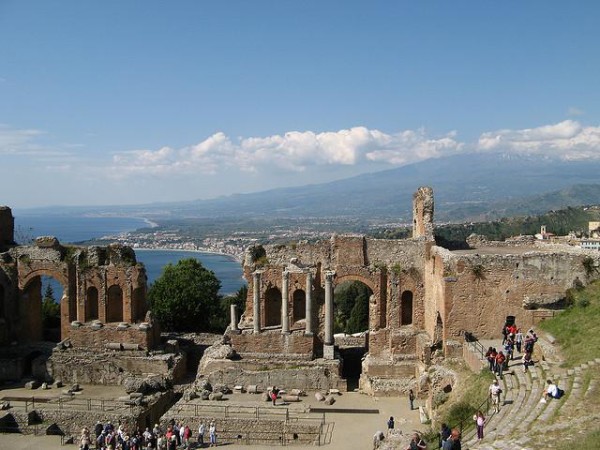Scattered around the Mediterranean lie the remains of the ancient theaters of the Greek and Roman world. The Greek theaters were large, open-air structures constructed on the slope of a hill. Roman theaters, although heavily influenced by the Greeks, have specific differences, such as being built upon their own foundations.
The theater originates from the city-state of Athens where it was used for festivals honoring the god Dionysus and the famous Athenian tragedy, comedy, and satyr plays. The Romans, being a little bit less philosophical in spirit than the Greek, wanted more pure entertainment with lots of laughs and excitement. Popular entertainments in Roman times included mime plays, acrobatics, jugglers, animal fights and gladiator fights although the later two were more common in the Roman amphitheater.
Greco-Roman Theatre
Taormina was a Greek colony on the east coast of the island of Sicily. The theater of Taormina was built by the Greeks in the 2nd century BC and restructured and widened by the Romans. The ancient theatre is beautiful situated, overlooking the bay of Naxos and mount Etna. Today it is the center of the Taormina’s international film festival.
Jerash Theatres
Jerash is a popular archaeological site in Jordan, second only to Petra. The city’s golden age came under Roman rule and the site is now generally acknowledged as one of the best preserved Roman provincial towns in the world. Jerash contains not one but two Roman theatres. The north theatre, with a capacity of 1600, was built in 165 AD and was mainly used as the city council chamber. The larger south theatre was built between 90-92 AD and could seat more than 3000 spectators.
Delphi Theatre
In ancient times Delphi was the most important site in ancient Greek religion, home to the sanctuary and oracle of Apollo. The ancient theatre of Delphi in Greece was built on a hill giving spectators a view of the entire sanctuary and the spectacular landscape below. It was originally built in the 4th and could seat 5,000 spectators.
Bosra
Situated 140 Km south of Damascus in Syria, Bosra is an ancient city that was already mentioned in the 14th century BC by Egyptians hieroglyphs. The city was conquered by the Romans in 106 AD who made it the capital of their Arabia province. The theatre of Bosra was built in the 2nd century AD and could seat up to 15,000 people. Because a fortress was built around the theatre by the Ayyubids it is now one of the best preserved Roman theatres in the world.
Epidaurus
The theatre of Epidaurus, located on the northeastern corner of the Peloponnesus in Greece, was constructed in the 4th century BC. It is still one of the most beautiful Greek theatres in the world. Unlike Roman theatres the view on a lush landscape behind the scene is an integral part of the theater itself. The theatre of Epidaurus is famous for its exceptional acoustics. Actors on stage can be perfectly heard by all 14,000 spectators, regardless of their seating.



